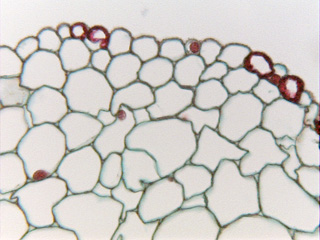Up
Ordinary epidermis
Guard cells
Thick cuticle
Thicker cuticle
Thin cuticle
Parasitic plant
Petal epidermis
Sclerified epidermis
Papillose epidermis
Sculptured cuticle
Elaborate cuticle
Cuticular horns
Radial walls
Cuticle proper
No epidermis
Epidermal peels
Cycad peel
Paradermal
Typical stoma
Sunken stoma
Stomatal orientation 1
Unusual orientation 2
Artifact
Stomata and fibers
Stomatal crypts
Crypts, mag.
Crypt margin
Non-crypt
Water lily
Stomatal channels
Groove, hi mag
Subsidiary cells
Ledges
Papillae
Trichome
Uniseriate hair
Peltate hair, mag
Peltate, lo mag
Branched hairs
Trichome base
Lithocyst, Ficus
Lithocysts, hemp
Bulliform cells
Grass epidermis
Multiple epi
Uniseriate?
Peperomia
| |
 Fig.
10.2-6. Transverse section of Indian-pipe stem (Monotropa).
Indian-pipe is parasitic
plant, one that attacks the roots of its host plant. Its body is a
subterranean, irregular mass of tissue that produces an inflorescence stalk that
pushes upward and raises the flowers above the soil surface where they can be
seen by pollinators. This inflorescence stalk is only a temporary structure, and
it has a very “inexpensive” construction: it consists mostly of parenchyma
and the epidermis cells have so little cuticle that it cannot be seen at this
magnification. Fig.
10.2-6. Transverse section of Indian-pipe stem (Monotropa).
Indian-pipe is parasitic
plant, one that attacks the roots of its host plant. Its body is a
subterranean, irregular mass of tissue that produces an inflorescence stalk that
pushes upward and raises the flowers above the soil surface where they can be
seen by pollinators. This inflorescence stalk is only a temporary structure, and
it has a very “inexpensive” construction: it consists mostly of parenchyma
and the epidermis cells have so little cuticle that it cannot be seen at this
magnification.
Note the lack of stomata: subterranean parasitic
plants carry out no photosynthesis, have no need to absorb carbon dioxide, and
have lost the ability to make stomata.
|
 Fig.
10.2-6. Transverse section of Indian-pipe stem (Monotropa).
Indian-pipe is parasitic
plant, one that attacks the roots of its host plant. Its body is a
subterranean, irregular mass of tissue that produces an inflorescence stalk that
pushes upward and raises the flowers above the soil surface where they can be
seen by pollinators. This inflorescence stalk is only a temporary structure, and
it has a very “inexpensive” construction: it consists mostly of parenchyma
and the epidermis cells have so little cuticle that it cannot be seen at this
magnification.
Fig.
10.2-6. Transverse section of Indian-pipe stem (Monotropa).
Indian-pipe is parasitic
plant, one that attacks the roots of its host plant. Its body is a
subterranean, irregular mass of tissue that produces an inflorescence stalk that
pushes upward and raises the flowers above the soil surface where they can be
seen by pollinators. This inflorescence stalk is only a temporary structure, and
it has a very “inexpensive” construction: it consists mostly of parenchyma
and the epidermis cells have so little cuticle that it cannot be seen at this
magnification.